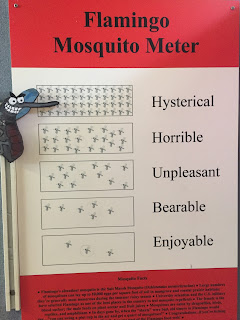If you’re not quite sure that it is safe to be doing something that you are doing,
then you are on an adventure.
Big Cypress is a sister to the Everglades National Park. They
share a border along the northern part of the national park and many of the
same features.
Like alligators.
Like alligators.
We hadn’t planned to go to Big Cypress. We were supposed to
relocate to a nice, safe trailer park right after the Everglades trip. But we
were nearby, there was a place to park, and it was someplace we had never seen
before. What better reason to stop and see it?
My first adventure blindsided me. I didn’t see it coming. We had planned on going on a tram tour of Shark Valley. That sounded nice and safe to me, so I was all for it. Except when we got there, we discovered that the route could be biked or walked.
My first adventure blindsided me. I didn’t see it coming. We had planned on going on a tram tour of Shark Valley. That sounded nice and safe to me, so I was all for it. Except when we got there, we discovered that the route could be biked or walked.

Normally, biking is not a particularly dangerous sport, unless it’s on the streets of Ottawa. But the signs posted at the tram center indicated the length of ride, 15 miles or so, and the lack of shade. We hadn’t planned for this activity, but we did have drinking water and bikes with us. I mean, honestly, who doesn’t always carry their bikes and their canoe everywhere they go? But I had no sunscreen as the signs advised. This was dangerous in my mind, and I wasn’t entirely sure we should be doing it.
But we were on an adventure.
So off we biked, on a paved trail along a deep canal. We saw
lots of big fish (but had left the fishing pole back at the truck, much to
hubbys’s chagrin) and quite a few wading birds in the water.

And many, many alligators sunning themselves on the grass verge between the canal and the pavement. Seemingly totally unconcerned by the people, bicycles and trams whizzing by their noses or tails.

And many, many alligators sunning themselves on the grass verge between the canal and the pavement. Seemingly totally unconcerned by the people, bicycles and trams whizzing by their noses or tails.

We had a break 7 miles in, at an observation tower, where you rest your legs by walking up a ramp to an elevation of about 100 feet. I wasn’t sure I should do that, either, because I might not have the muscles left to peddle my way back to the tram station.
But we were on an adventure.
I did make it to the top, and I even survived the bike ride
back just a little more sun tanned than when I started. A successful adventure!
I could see the second adventure coming. It gave me something
to fret over for a full day.

Hubby wanted to paddle the Turner River canoe trail.
Rivers down here are nothing like the rivers in Canada. They don’t meander alongside fields and through pretty forests with defined landmarks so you know where you are.
No, they twist and turn around confusing clumps of tall sawgrass and through low tunnels of mangrove roots.
I wasn’t sure I should be doing this. This particular canoe
trail did not even have the markers every few feet like the last one we were
on, when we still managed to get lost a couple of times!
But we were on an adventure.
So we took the canoe off the truck and locked the bikes
inside. I mean, really, who doesn’t travel like this?

We paddled down the first part of the river, strewn with alligators basking on top of the river grass.

We played pinball machine with the canoe in the mangroves, bouncing the boat off the roots during the turns, and bending low to be able to pass by the branches that were only 2 feet off the surface of the water.
In some spots, there was very little place to put the paddle in the water. It was easier to use the branches and roots around us to pull us through the obstacles.
It wasn’t comfortable, but it was an adventure.
And when we had made it safely back to the trailhead and the
truck, I realized that it had been a lot of fun.
For an adventure.
W






















